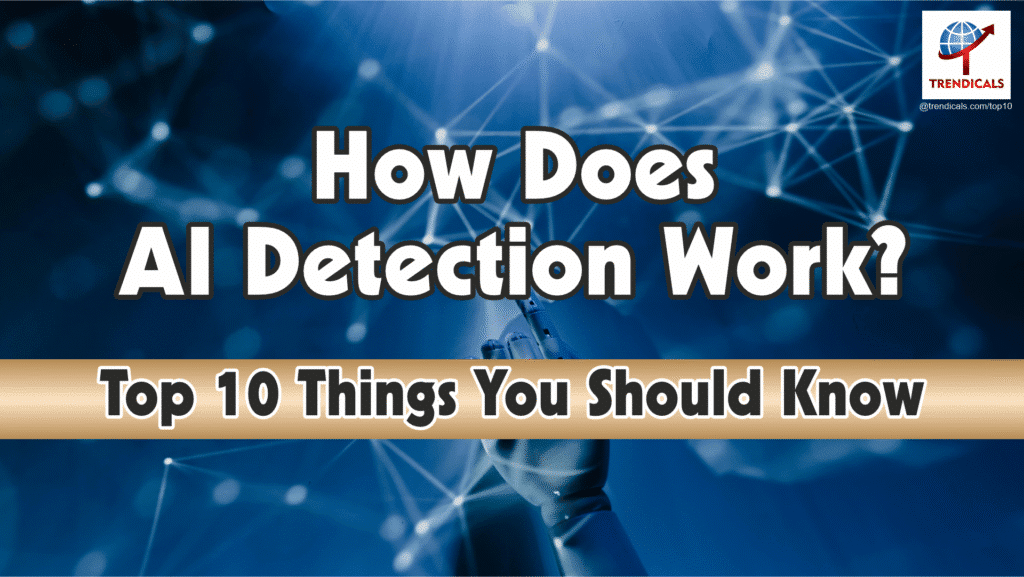Introduction: Why AI Detection Matters
In the age of intelligent machines, artificial intelligence (AI) tools like ChatGPT, Bard, and Claude are reshaping how we create content, write essays, generate emails, and even craft poetry. But as AI-written content becomes increasingly difficult to distinguish from human writing, the need for AI detection tools has become urgent — especially in education, journalism, content marketing, and academic research.
So, how does AI detection work, and why should you care? In simple terms, AI detection involves identifying whether a piece of content was created by a human or an AI model. Detectors use a variety of advanced techniques such as perplexity, machine learning, stylometry, and more to make this determination.
In this article, we’ll uncover the Top 10 Things You Should Know about AI detection — from the core technology behind it to the industries that rely on it.
🔟 Top 10 Things You Should Know About How AI Detection Works
1. Perplexity and Burstiness: The First Line of Defense
AI detection tools often begin with analyzing two key metrics: perplexity and burstiness.
Perplexity measures how predictable a sentence is to a language model. AI-generated content tends to have lower perplexity because it follows a smoother and more formulaic structure.
Burstiness refers to how varied the writing is. Human writing usually has more variation in sentence length, tone, and structure, while AI writing is often more uniform.
For example, consider these two sentences:
Human: “It was a sunny afternoon when Sarah, half-lost in thought, decided to revisit the bookstore where it all began.”
AI: “It was a nice day. Sarah went to the bookstore. She liked books.”
AI content often lacks creative rhythm and complexity. Tools like GPTZero use this insight to make early predictions.
2. Machine Learning Models Power the Detection Engine
Modern AI detectors are trained using supervised learning. They are fed large datasets that include labeled examples of human-written and AI-generated texts.
The system learns to detect subtle differences in:
Vocabulary usage
Sentence structure
Syntax and grammar patterns
Predictability
Popular algorithms used include:
Logistic Regression
Random Forests
Neural Networks (especially transformer-based models)
Support Vector Machines
Some detection platforms like Originality.ai combine these models with user feedback loops to improve over time.
>>>Top 10 AI Tools To Grow Your Business (Click here to read the article)
3. Repetitiveness and Generic Language Are Telltale Signs
AI models are trained on large datasets and often use safe, generic language that may sound polished but lacks depth or personal experience.
Indicators of AI-generated text:
Repetitive phrases (e.g., “In conclusion,” “It is important to note that…”)
Overuse of transitions and filler sentences
Lack of emotional nuance or subjective judgment
Detectors flag these patterns because human writers tend to introduce inconsistencies, personal bias, or stylistic quirks — things that are harder for AI to replicate.
4. Stylometry: Every Writer Has a Fingerprint
Stylometry is the statistical study of writing style. It can identify an author’s “writing fingerprint” based on:
Punctuation frequency
Word choice
Sentence length
Syntax patterns
For example, Hemingway’s writing is known for short, direct sentences, while Tolkien’s prose is more descriptive and complex. AI detection tools use stylometry to compare a sample with known human writing styles. If the sample deviates from natural patterns, it’s flagged.
5. Token Analysis: Tracking the Building Blocks of AI
Large Language Models (LLMs) like GPT generate content by predicting the next token, which is a chunk of a word or punctuation.
Detectors analyze how these tokens are assembled:
Does the sentence flow too perfectly?
Are transitions too consistent?
Are certain token sequences unnaturally frequent?
AI models often use the most statistically likely next token — this can create robotic or overly fluent text. Tools like Turnitin’s AI Detection monitor token flow to identify AI authorship.
6. Watermarking and Metadata (Experimental Features)
Some newer methods of detection involve watermarking — where AI-generated content contains hidden signals embedded in the token sequence.
OpenAI researchers have explored this idea: adding a digital signature that’s invisible to readers but detectable by software. While not widespread yet, watermarking could become a standard feature in future AI models.
Similarly, metadata analysis (checking timestamps, author IDs, etc.) is used in educational platforms or closed writing environments to track who wrote what.
>>>Top 10 AI Tools for Youtubers (Click here to read the article)
7. Detectors Can Be Fooled By Smart Editing
One major limitation of AI detection is that heavily edited or paraphrased AI text often bypasses detection. If a human revises the content enough — changes structure, adds unique vocabulary, or inserts personal anecdotes — it becomes harder to detect.
This is especially true for tools relying solely on perplexity or grammar cues. That’s why combining tools with manual review is often recommended.
8. Industries Where AI Detection Is Essential
AI detectors are not just academic tools. They are used in various sectors:
🏫 Education:
Teachers use it to verify originality in student essays.
Prevents cheating in take-home assignments.
📰 Journalism & Media:
Ensures human-authored content in news stories and op-eds.
Maintains editorial integrity.
💼 Business & Marketing:
Confirms human creativity in ad copy and branding.
Helps maintain trust in client communications.
📚 Publishing:
Verifies authorship for book submissions and blog posts.
9. There’s No Universal Detection Standard (Yet)
Different tools use different algorithms, thresholds, and scoring systems. A piece of content marked “100% human” by one tool might be labeled “likely AI” by another.
That’s why many experts suggest:
Using multiple detection tools
Pairing AI detection with plagiarism checks
Manual verification for critical content
10. AI Detection Is a Growing Field — Stay Updated
AI detection is not static. As AI writing improves, so must detection tools. Expect to see:
Better stylometric models
AI-assisted human editing detection
Improved cross-model detection (e.g., identifying content from unknown or open-source models)
It’s a cat-and-mouse game — and it’s only just beginning.
>>>Top 10 World Wide Technology Jobs (Click here to read the article)
📋 Quick Summary Table: How AI Detection Works
| 🔍 Component | 📖 Description |
|---|---|
| Perplexity & Burstiness | Measures predictability and variation in writing |
| ML Classification | Models trained on datasets to distinguish AI from human writing |
| Token Pattern Analysis | Tracks how AI models assemble content using tokens |
| Stylometry | Analyzes individual writing style, structure, and tone |
| Metadata & Watermarks | Tracks time, authorship, and embedded AI markers (experimental) |
❓ Frequently Asked Questions (FAQs)
Q1. Is AI detection the same as plagiarism detection?
No. Plagiarism detectors compare text to known sources, while AI detectors analyze how the text was generated. Both can be used together for stronger content verification.
Q2. Can I rely 100% on AI detection tools?
Not entirely. They are accurate most of the time but may give false positives or negatives. Human judgment is still important.
Q3. How do I bypass AI detection?
Ethically speaking, you shouldn’t try to bypass detection for dishonest purposes. However, human editing, rephrasing, and adding original thought can reduce AI-like patterns.
Q4. Do AI detectors work in multiple languages?
Most tools work best in English, but newer models are expanding to multilingual AI detection.
Q5. Are AI detectors free?
Some tools like GPTZero offer free versions, while others (like Turnitin or Originality.ai) are paid and more accurate.
🔗 Useful Links for Further Reading
📝 Conclusion: Be Aware, Be Authentic
Now that you know how AI detection works, you can better understand the evolving landscape of digital writing. Whether you’re a student turning in an assignment, a blogger crafting content, or an employer checking a report, staying aware of these tools is crucial.
As AI continues to improve, so will the methods for identifying it. In the end, combining human creativity with ethical use of technology will always create the best results.
Please don’t forget to subscribe us for more trending top 10 things in different fields
Please don’t forget to leave a review.read

